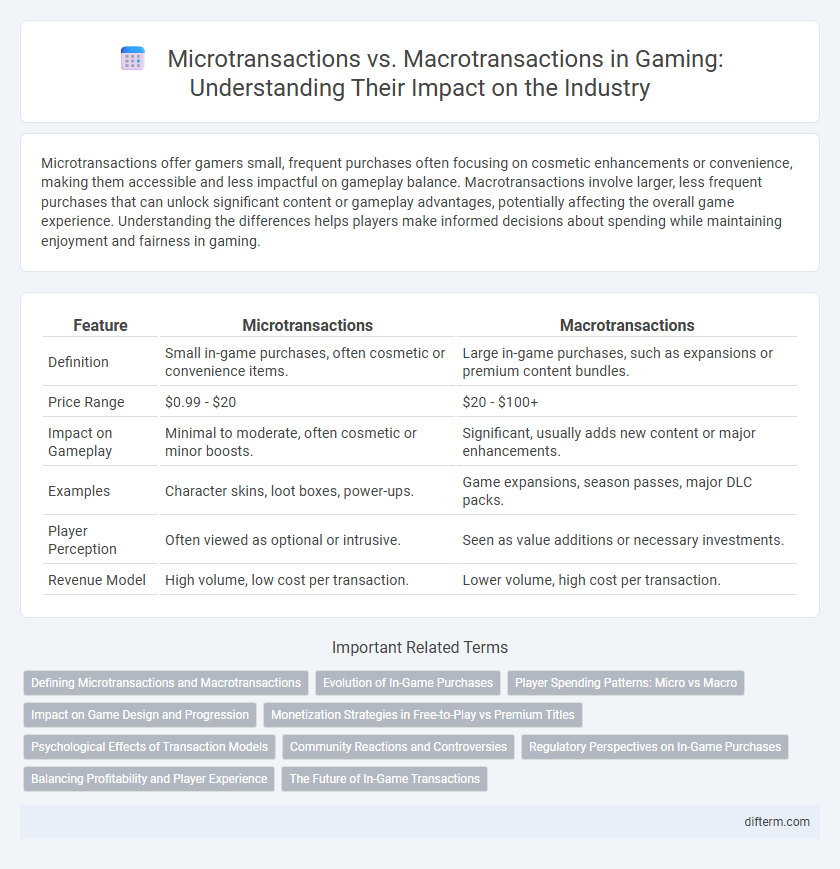Microtransactions offer gamers small, frequent purchases often focusing on cosmetic enhancements or convenience, making them accessible and less impactful on gameplay balance. Macrotransactions involve larger, less frequent purchases that can unlock significant content or gameplay advantages, potentially affecting the overall game experience. Understanding the differences helps players make informed decisions about spending while maintaining enjoyment and fairness in gaming.
Table of Comparison
| Feature | Microtransactions | Macrotransactions |
|---|---|---|
| Definition | Small in-game purchases, often cosmetic or convenience items. | Large in-game purchases, such as expansions or premium content bundles. |
| Price Range | $0.99 - $20 | $20 - $100+ |
| Impact on Gameplay | Minimal to moderate, often cosmetic or minor boosts. | Significant, usually adds new content or major enhancements. |
| Examples | Character skins, loot boxes, power-ups. | Game expansions, season passes, major DLC packs. |
| Player Perception | Often viewed as optional or intrusive. | Seen as value additions or necessary investments. |
| Revenue Model | High volume, low cost per transaction. | Lower volume, high cost per transaction. |
Defining Microtransactions and Macrotransactions
Microtransactions are small in-game purchases often ranging from $0.99 to $9.99, enabling players to buy virtual goods like skins, power-ups, or cosmetic items. Macrotransactions, on the other hand, involve higher-value purchases typically exceeding $20, such as full game expansions, season passes, or bundles that provide extended content. Both types of transactions contribute to monetization strategies in gaming but cater to different spending behaviors and player engagement levels.
Evolution of In-Game Purchases
Microtransactions have evolved from simple cosmetic items to intricate systems involving loot boxes, battle passes, and seasonal content, significantly increasing player engagement and revenue streams. Macrotransactions encompass larger, one-time purchases such as full game expansions, premium editions, and exclusive content bundles, often providing substantial gameplay enhancements. The gaming industry's shift towards diverse in-game purchase models reflects an emphasis on both immediate revenue and long-term player retention strategies.
Player Spending Patterns: Micro vs Macro
Player spending patterns in gaming reveal distinct behaviors between microtransactions and macrotransactions, with microtransactions typically involving frequent, low-cost purchases such as cosmetic skins or in-game currency. Macrotransactions, on the other hand, consist of less frequent but higher-value purchases like game expansions or premium content bundles. Data from industry reports indicates that microtransactions drive a larger volume of revenue through repeated small spends, while macrotransactions impact player retention through substantial initial investments.
Impact on Game Design and Progression
Microtransactions often influence game design by encouraging frequent small purchases that can disrupt balanced progression, leading developers to create grind-heavy mechanics to incentivize spending. Macrotransactions, involving larger, less frequent purchases, tend to impact endgame content or cosmetic customization without significantly altering gameplay flow. Both transaction types shape player engagement and retention strategies, but microtransactions pose greater risks for pay-to-win dynamics affecting game fairness.
Monetization Strategies in Free-to-Play vs Premium Titles
Microtransactions dominate free-to-play games by offering players incremental purchases like cosmetic items, power-ups, or virtual currency, driving sustained revenue through frequent small transactions. Premium titles typically rely on macrotransactions, such as paid expansions or season passes, providing substantial content additions or exclusive features for one-time or less frequent larger payments. Effective monetization strategies balance player engagement and spending behavior, optimizing revenue streams according to the game's business model and target audience.
Psychological Effects of Transaction Models
Microtransactions create frequent, small spending decisions that trigger dopamine release, reinforcing habit formation and impulsive buying behaviors in gamers. Macrotransactions, involving larger, less frequent purchases, tend to engage more deliberate decision-making processes, often linked to perceived value and investment in the gaming experience. Both transaction models exploit psychological principles such as loss aversion and reward anticipation, but microtransactions amplify compulsive tendencies through constant, low-cost reinforcements.
Community Reactions and Controversies
Microtransactions often trigger community backlash due to perceived pay-to-win mechanics and unfair advantages, causing divisive debates on game fairness and developer intent. Macrotransactions, involving larger, often cosmetic purchases, tend to generate less controversy but still face criticism when players view them as exploitative or undermining gameplay balance. Both transaction types impact player engagement and trust, influencing overall community sentiment and long-term game sustainability.
Regulatory Perspectives on In-Game Purchases
Regulatory perspectives on in-game purchases increasingly focus on distinguishing microtransactions, which involve small, frequent payments, from macrotransactions that encompass larger, less frequent purchases within gaming ecosystems. Authorities evaluate the psychological impact, transparency, and monetary thresholds to implement consumer protection laws aimed at preventing exploitative spending, especially among minors. Enhanced regulations mandate clear disclosure of costs, odds in loot boxes, and enforce spending limits to foster ethical monetization practices in gaming.
Balancing Profitability and Player Experience
Microtransactions, involving small, frequent purchases like cosmetic items or boosts, generate steady revenue while maintaining player engagement, whereas macrotransactions, which are larger one-time purchases such as season passes or premium content, offer significant upfront profit. Balancing profitability with player experience requires carefully designing microtransactions to avoid pay-to-win dynamics that can frustrate users and diminish long-term retention. Effective monetization strategies leverage data analytics to optimize pricing models and ensure in-game incentives align with player satisfaction and fair competition.
The Future of In-Game Transactions
Microtransactions dominate current gaming economies with small, frequent purchases such as cosmetic items or power-ups, driving steady revenue streams for developers. Macrotransactions, involving larger, one-time purchases like season passes or full-game expansions, are gaining traction as gamers seek more substantial content and value. The future of in-game transactions likely blends both models, leveraging data-driven personalization and blockchain technology to enhance player engagement and secure digital ownership.
Microtransactions vs Macrotransactions Infographic

 difterm.com
difterm.com